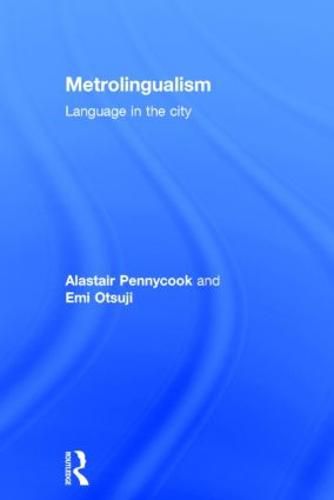Readings Newsletter
Become a Readings Member to make your shopping experience even easier.
Sign in or sign up for free!
You’re not far away from qualifying for FREE standard shipping within Australia
You’ve qualified for FREE standard shipping within Australia
The cart is loading…






This book is about language and the city. Pennycook and Otsuji introduce the notion of ‘metrolingualism’, showing how language and the city are deeply involved in a perpetual exchange between people, history, migration, architecture, urban landscapes and linguistic resources. Cities and languages are in constant change, as new speakers with new repertoires come into contact as a result of globalization and the increased mobility of people and languages.
Metrolingualism sheds light on the ordinariness of linguistic diversity as people go about their daily lives, getting things done, eating and drinking, buying and selling, talking and joking, drawing on whatever linguistic resources are available. Engaging with current debates about multilingualism, and developing a new way of thinking about language, the authors explore language within a number of contemporary urban situations, including cafes, restaurants, shops, streets, construction sites and other places of work, in two diverse cities, Sydney and Tokyo. This is an invaluable look at how people of different backgrounds get by linguistically.
Metrolingualism: Language in the city will be of special interest to advanced undergraduate/postgraduate students and researchers of sociolinguistics and applied linguistics.
$9.00 standard shipping within Australia
FREE standard shipping within Australia for orders over $100.00
Express & International shipping calculated at checkout
This book is about language and the city. Pennycook and Otsuji introduce the notion of ‘metrolingualism’, showing how language and the city are deeply involved in a perpetual exchange between people, history, migration, architecture, urban landscapes and linguistic resources. Cities and languages are in constant change, as new speakers with new repertoires come into contact as a result of globalization and the increased mobility of people and languages.
Metrolingualism sheds light on the ordinariness of linguistic diversity as people go about their daily lives, getting things done, eating and drinking, buying and selling, talking and joking, drawing on whatever linguistic resources are available. Engaging with current debates about multilingualism, and developing a new way of thinking about language, the authors explore language within a number of contemporary urban situations, including cafes, restaurants, shops, streets, construction sites and other places of work, in two diverse cities, Sydney and Tokyo. This is an invaluable look at how people of different backgrounds get by linguistically.
Metrolingualism: Language in the city will be of special interest to advanced undergraduate/postgraduate students and researchers of sociolinguistics and applied linguistics.